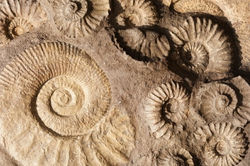
Foraminifera, whats is this?
Foraminifera are protozoans with a skeleton that is readily preserved in the fossil record. Both planktic (i.e., living in the water column) and benthic (i.e., living on the sea floor) species occur and have for decades been subject of extensive research. Their paramount importance for (paleo-) environmental studies is well-known in academy as well as in industry.
Microfossils, such as foraminifera, are of high importance since they occur in a variety of marine environments and through the geological time.
In oil and gas exploration biostratigraphy and paleoenvironmental reconstructions are the most common applications of microfossils. Whereas biostratigraphy provides the temporal constraint of rock units based on the fossil content, paleoenvironmental reconstruction provides the interpretation of the depositional environment in which the rock was formed. The main advantage of the microfossils is represented by the small dimension of such organisms which allow interpretation using cuttings and cores from boreholes. Another advantage is the relatively easy and safe Oil and gas preparation, ideal also for results in brief time, such as hot shot and during on-time drilling operation.


















Sedimentary Basins
Sedimentary basins are regions of Earth of long-term subsidence creating accommodation space for infilling by sediments. Sedimentary basins occur in diverse geological settings usually associated with tectonic activity.
As the sediments are buried, they are subjected to increasing pressure and begin the process of lithification. Some basins are formed in extensional settings can undergo inversion which has accounted for a number the economically viable oil reserves on earth which were formerly basins.














Biostratigraphy
Rocks formed during any interval of geologic time can be recognized and distinguished by their fossil content from rocks formed during other time intervals.
Most foraminifera species have limited time ranges, generally less than a couple of million years. One of the things that paleontologists try to do is to identify the age at which a species first evolves (this is called the FAD; the First Appearance Datum) and the age at which a species dies off (the LAD; last appearance datum).
Last appearance datum (LAD) The latest (highest) occurrence in a stratigraphic section for a foraminifera species. Last appearance occurs when the species is no longer able to adjust to shifting environmental conditions, its members decrease in number and eventually disappear. Extinction It refers to the disappearance by death of every individual member of a species or higher taxonomic group so that the lineage no longer exists.
Index fossils or Marker fossils. A species or genus of fossils that provides for especially precise correlation. Ideally, should be: (1) independent of their environment [i.e. common in many kinds of sedimentary rocks]; (2) fast evolving [i.e. restricted to a narrow stratigraphic interval]; (3) geographically widespread; (4) abundant; (5) readily preserved; (6) easily recognizable (from other taxa).
 |  |  |
|---|---|---|
 |
An Unprecedented Design:
Automated Identification of Microfossils

“Automated Identification & Classification of microfossils in support of the Oil & Gas exploration.” Designed to a real time support to the offshore oil rig.
The objective of the project is to structure, develop, and pilot a microfossil automated identification & classification system, to provide Real Time operational support to the activities of exploration and production of oil & gas, in the offshore environment. The description of its fundamentals and future operations focuses on the identification and classification of planktonic foraminifera, however, if successful, it can also be employed to identify other biological species.
The system provides the study and architecture of deep learning neural network for identification & classification of biological markers, from digital images from real samples, through automated selection and classification of fossil species, indicators of geological time line (biozones), contained in 2D/3D digital images.
The project, with features of R&D, offers practical objectives and intend to be applied in the oil industry, based on solid foundations of biostratigraphy, digital image processing of robot operations, supported by deep learning neural network systems.
Finally, the unprecedented proposal is based on the knowledge integration of advanced fields of science (paleontology, graphic and visual computing, and Learning Machine). Therefore, its development will require trials in the mentioned fields to determine the most appropriate actions to accomplish such purposes.
Looking for

Thanks for climbing to the final banner.
After several years negotiating with PETROBRAS the financing to complete the project, the pandemic turmoil seems to frustrate my expectations. Its completion requires the involvement of Deep Learning experts and investors who believe in its economic potential.
This home page aims to draw the attention of partners interested in finalizing the project “Automated Identification & Classification of microfossils in support of the Oil & Gas exploration.”
What I'm looking for:
-
Partners with expertise in Deep Learning Machine in identification and selection of 2D/3D digital images
-
Financing to performer the final stages of the project and to conduct the offshore pilot tests
What is offered:
-
An opportunity to generate a high sophisticated tool
-
Being the owner of a very profitable operating system
-
Solid relationship with PETROBRAS* (as a potential partner)
-
Full mastery of the technique and the system usage
-
Collection of Marker Species from Brazilian sedimentary basins
-
Full-time apply in the project
My best regards
PETROBRAS* - Petróleo Brasileiro SA. – Brazilian State owner oil corporation.
About the Author
Prof. Juarez Fontana MSc. PhD.

-
Geologist & Micropaleontologist
-
Geology graduation – 1967 – RGS Federal University
-
MSc. Economic Geology - 1987– São Paulo University
-
PhD. Natural Resources Management – 1997 – Campinas University – SP
-
Oceanography 101 – University of Whashington - USA
-
Former Head of Plank Foraminifera Department of PETROBRAS Research Center (CENPS)
-
Published the first Plank Foraminifera biostratigraphy scale of the Brazilian offshore sedimentary basins.
-
Graduation and PostGraduation Courses: professor in Geology and Oceanography courses - Parana Federal University; UNESP University; São Judas University.
-
Principal of Bachelor Course of Technology of Oil & Gas, Geoscience and Oceanography in São Judas University – SP.
About the Author


